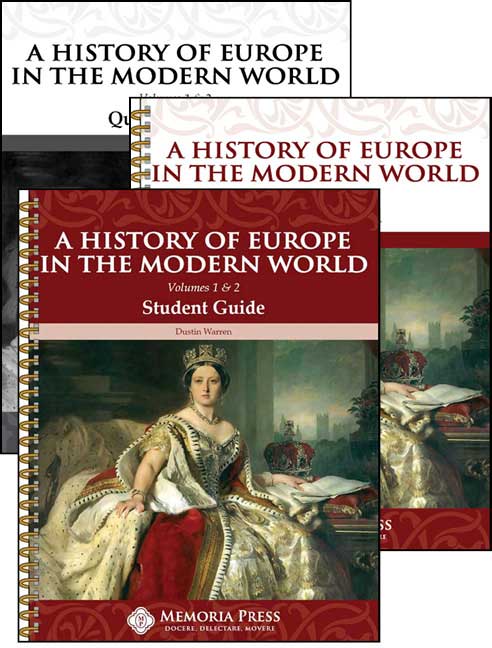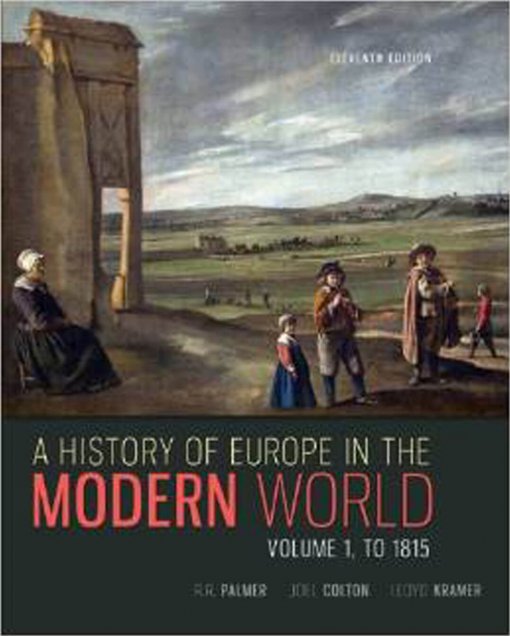Memoria Press has created A History of Europe in the Modern World, a high school course that can be used for either one or two years. The course is a study of world history with the primary focus on Europe and the development of western civilization.
The Textbooks
The course is built around two excellent McGraw Hill textbooks, A History of Europe in the Modern World: Volume 1, to 1815 and A History of Europe in the Modern World: Volume 2, Since 1815. The textbooks were written by R. R. Palmer, Joel Colton, and Lloyd Kramer, and they were originally published in 1995. They’ve been republished a number of times since, and the Memoria Press course uses the eleventh editions of these books that were published in 2014. The two books are really one, since the second volume starts with Chapter 11 and page 449. There are well over a thousand pages between the two books, and a single volume would have been very unwieldy. While a student can complete both volumes in one year, the reading load would be heavy, with up to 50 pages a week—and there's additional work in the student guide to consider as well.
Volume 1 begins with a brief overview of the roots of European civilizations, particularly in ancient Greece, ancient Rome, and early Christianity. It continues up through 1815, then Volume 2 picks up in 1815 and continues through 2013.
The textbooks cover historical events and key characters, but they go deeper than most high school textbooks into why things happened. They explore political developments, personality clashes, religious beliefs, sociological developments, and other factors that influenced the direction of history.
For instance, the second volume of the textbook devotes eight pages (plus two pages of maps) to the Fourteen Points, the Treaty of Versailles and other treaties signed at the end of World War I, and the outcomes of those events. In the final paragraph of that section, it sums up the broader historical results:
The First World War dealt a last blow to the ancient institutions of monarchy and aristocratic feudalism. Thrones toppled in Turkey, in Russia in Austria-Hungary, in the German Empire and in the individual German states; and with the kings went the courtly retainers and all the social preeminence and special advantages of the old landed aristocracies (p. 733).
This in-depth discussion is typical throughout both textbooks. It makes history much more interesting and meaningful, but it does require more reading and a deeper level of critical thinking than is usual for high school.
Ancillary Items
 Memoria Press has created a single teacher manual and a single student guide to cover both volumes of the textbook. The course is intended to be interactive, with someone teaching the course.
Memoria Press has created a single teacher manual and a single student guide to cover both volumes of the textbook. The course is intended to be interactive, with someone teaching the course.
The teacher manual begins with information explaining how to teach the course and use the course components. This section includes essay guidelines and samples essays. Then for each chapter, it provides an introduction, a detailed overview that lists and describes key points, a summary, and a conclusion. All of these could be presented to students by the teacher. The teacher manual also has either reduced or full-size images of the student guide pages with overprinted answers.
A student can work independently through the course even though the teacher manual advises against it. A parent of a student working independently might still read some of the content from the teacher manual to the student—maybe the introduction, summary, and conclusion. If a student isn’t grasping the key points, that should alert the parent that more interaction is required, and perhaps add a review of the outline of key points with the student.
Quizzes and tests for the entire course are provided as perforated pages in a separate Quizzes & Tests book. Answer keys for the quizzes and tests are at the back of the teacher manual. The teacher manual identifies questions or items in the student guide that will appear on tests, and it encourages teachers to let students know about these items so they can better concentrate their study time for tests. There is so much content in the textbooks, that it makes sense to assist students in this way.
The student guide is a 219-page, spiral-bound workbook. A teacher might introduce a chapter with two items that appear near the beginning of each chapter in the student guide: the "Summative Quote and “Hooks”—questions for students to ponder or discuss before starting the chapter. (Students working independently could ponder these on their own, but it’s not as effective as discussing them.)
Students need to read in their textbook before completing the rest of the pages in their guide. For each chapter, the student guide begins by having students write a one- or two-sentence summary of the entire chapter. Then it has Key Terms, Key Figures, Key Dates, and Key Structures for which they will write out identifications or explanations on the lines provided. Next are comprehension questions for which students are to write out answers that are about three to five sentences in length. Following the comprehension questions are a short essay question, a timeline entry assignment, and a map activity. You might assign all of these, or you might be selective.
Interestingly, Memoria Press does not have any content in either the student guide or teacher book for the final chapter in the textbook, and it is omitted in the discussion of the course’s schedule. This is because the final chapter (written from a left-of-center point of view in my opinion) addresses many contentious topics. So parents and teachers have to decide whether or not to have students read that chapter, and they will have to create their own assignments if they do so.
The teacher manual also recommends memorization and recitation of the poem “In Flanders Fields” and occasionally having students draw their own political cartoons. A Recitation Rubric in the teacher guide will help with the evaluation of the student’s presentation of the poem.
Summary
A History of Europe in the Modern World should be an excellent course for students ready to work at a challenging level.









